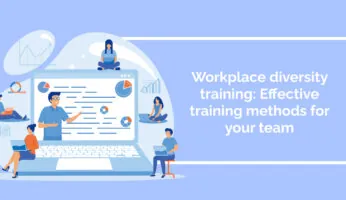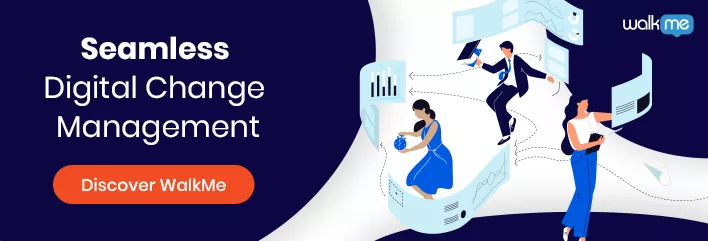
Change management theory refers to the concepts, models, frameworks, and methodologies used to manage the people side of organizational change.
Navigating change is never easy in personal and professional life. However, change management theories provide a structured approach to help individuals and organizations navigate and adapt to environmental changes.
More companies are undergoing enterprise-scale transformations than ever before. It’s easy to see why change initiatives are so popular as digitalization continues to change how businesses operate.
Organizational change is vital in meeting the expectations of modern customers using new processes.
So, why are businesses failing to achieve their desired results? Research shows that half of change initiatives fail, and only 34% succeed.
They consist of methodologies, concepts, and theories for implementing change. A change management framework will help you overcome common obstacles and avoid pitfalls many companies fall into.
In addition to exploring the top eight concepts for change management theory, we will also cover the following topics:
- What is a Change Management Theory?
- Why is choosing the right change management theory important?
- The 5 best change Management theory choices in 2022
- How do you choose the best change management theory?
Why is a change management theory important?
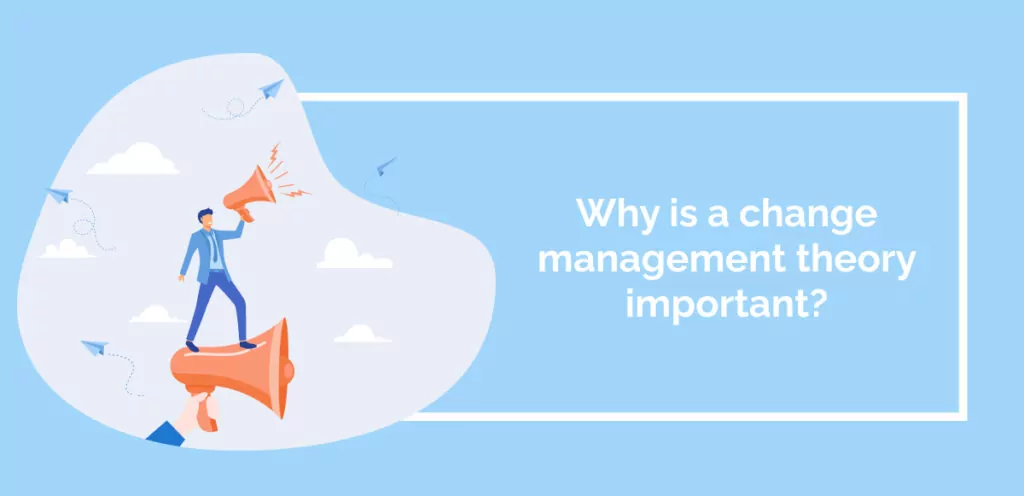
Dan Levin: The importance of change management
A change management theory is important to success because companies often waste valuable investments in technology or processes because they don’t know how to achieve lasting change in 2023.
Using a change management theory is a guideline to ensure your company’s efforts pay off.
The best change management models combine practice and theory to give change managers the materials they need to succeed in organizational change.
A change management framework is essential for organizations seeking a new status quo.
8 main features of a change management theory

A change management theory offers many advantages and provides eight main features.
These eight features include:
- Effective forecasting: Change management theory can help you forecast future trends effectively, allowing preparation and resource allocation to stay competitive.
- Measurable results: Using a change management theory makes measuring results easier in line with your employee workflows.
- More manageable accountability: When you utilize a change management theory, accountability becomes more manageable.
- Higher confidence: The ability to respond positively to change gives your organization much higher confidence, especially toward innovative and creative ideas that move away from the status quo.
- Lower resistance: A change theory helps reduce resistance to change as employees understand that change has positives for everyone.
- Faster ROI: Successful change means faster ROI, and a change management theory facilitates this.
- Clearer roles: Change theories often contain ways to allocate roles clearly for methodical change initiative implementation.
- A collaborative approach: Change requires collaboration, and change theories support this idea with specific strategies.
Consider these features when choosing a change management theory to ensure the model meets your needs.
Top 8 concepts for change management theory
Consider these ten best change management theory choices for your change management efforts in 2023.
1. Lewin’s Change Management Model
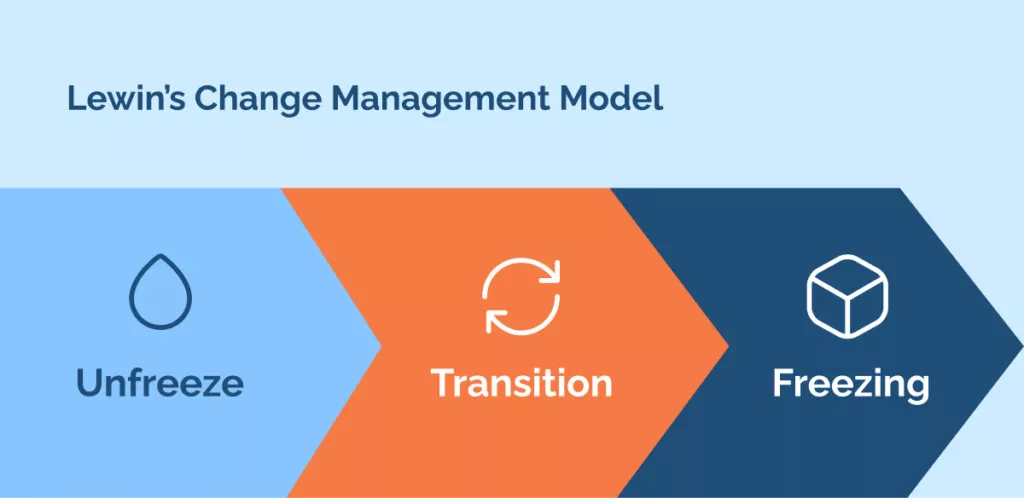
Many experts consider Kurt Lewin one of the forbears of change management, organizational development, and social psychology, which is why Lewin’s change management model is our number one change management theory.
Lewin’s change management model is straightforward, yet its simplicity makes it powerful.
How it works
Lewin states that every change follows a 3-step process that addresses existing mindsets:
- Unfreezing.
- Transition.
- Freezing.
1. Unfreezing
First, a process must shift away from its current state. It’s necessary to overcome inertia, bypass defense mechanisms, and dismantle present viewpoints.
2. Transition
The second stage is where the change occurs. It can involve confusion and uncertainty. The end goal is not always clear.
3. Freezing
The final transition stage involves replacing the old ways of thinking and operating. During this stage, people return to their comfort zone and feel more comfortable with this new status quo.
Who is it best for?
Lewin’s change management model is one of the most popular, making it suitable for any organization, from SMEs to large enterprises.
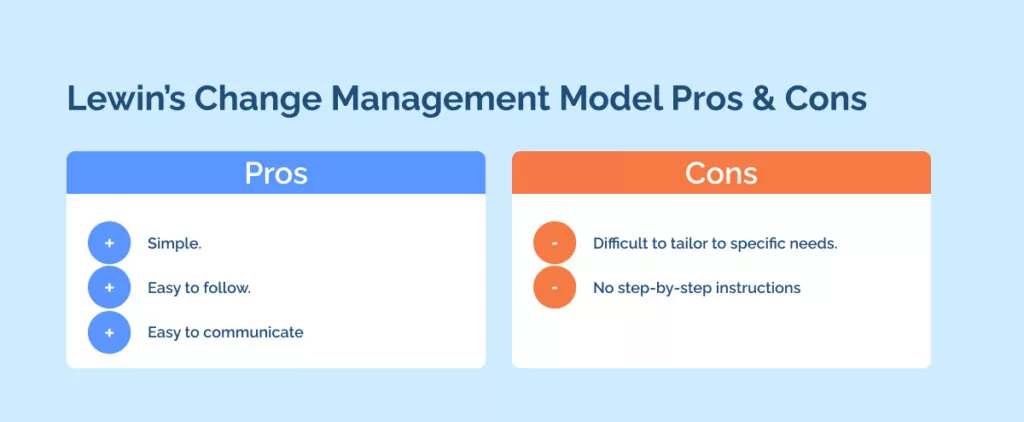
Pros
- Simple.
- Easy to follow.
- Easy to communicate.
Cons
- Difficult to tailor to specific needs.
- No step-by-step instructions.
2. Kotter’s 8-step model for change
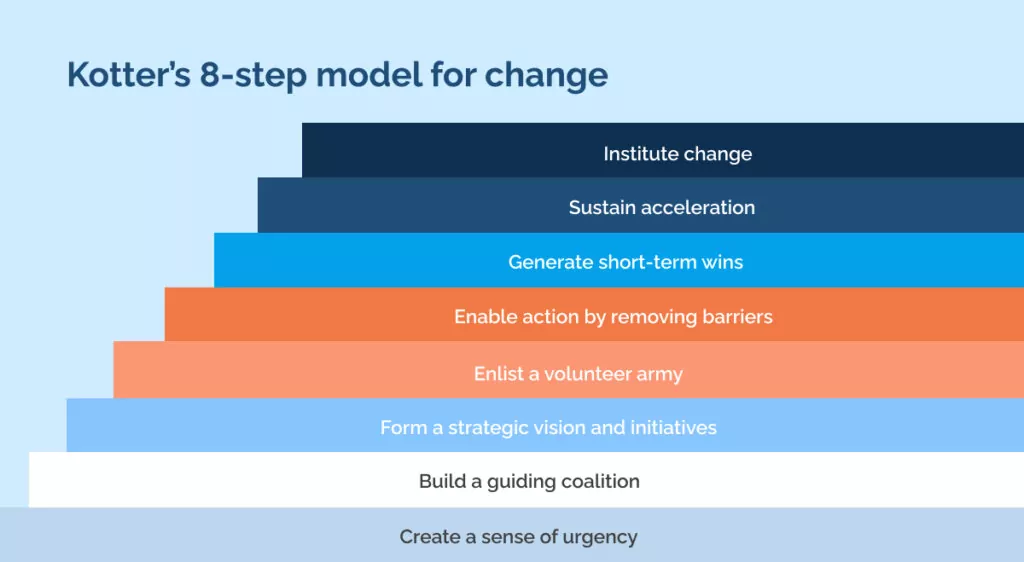
John Kotter is a leading authority in the change management industry.
His change management framework is designed explicitly around organizational change, so we chose Kotter’s eight-step model for change as number two in our list of eight concepts for change management theory.
How it works
Kotter’s model consists of eight steps.
The steps are as follows:
- Create a sense of urgency.
- Build a guiding coalition.
- Form a strategic vision and initiatives.
- Enlist a volunteer army.
- Enable action by removing barriers.
- Generate short-term wins.
- Sustain acceleration.
- Institute change.
The only downside to this model is that it focuses more on strategy and organizational development than employees, ignoring that employee feedback is an essential element of change.
Listening to employee voices and acting on feedback is critical to avoid employee frustration and resistance.
Consider pairing Kotter’s model with other change models for maximum benefits.
Who is it best for?
Kotter’s eight-step model for change aims toward larger enterprises that need step-by-step instructions as they implement change management models over long periods, reviewing and adjusting their organizational structure along the way.
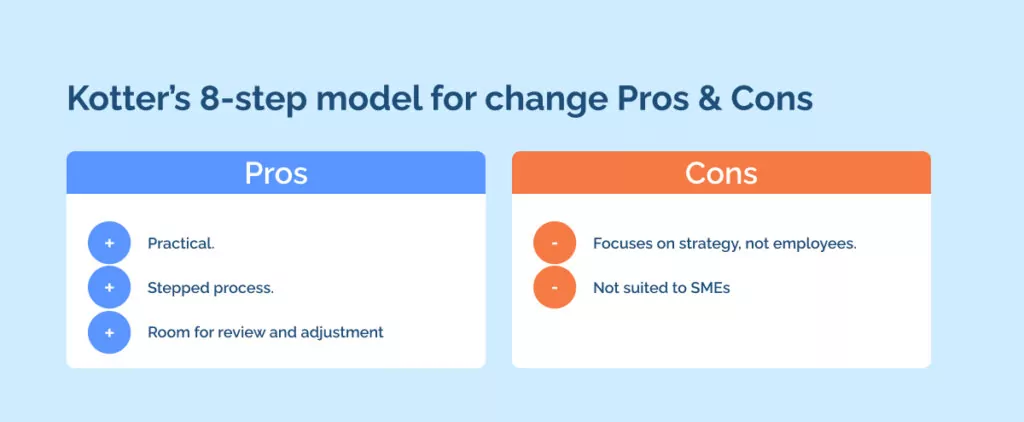
Pros
- Practical.
- Stepped process.
- Room for review and adjustment.
Cons
- Focuses on strategy, not employees.
- Not suited to SMEs.
3. Prosci’s ADKAR Change Management Framework
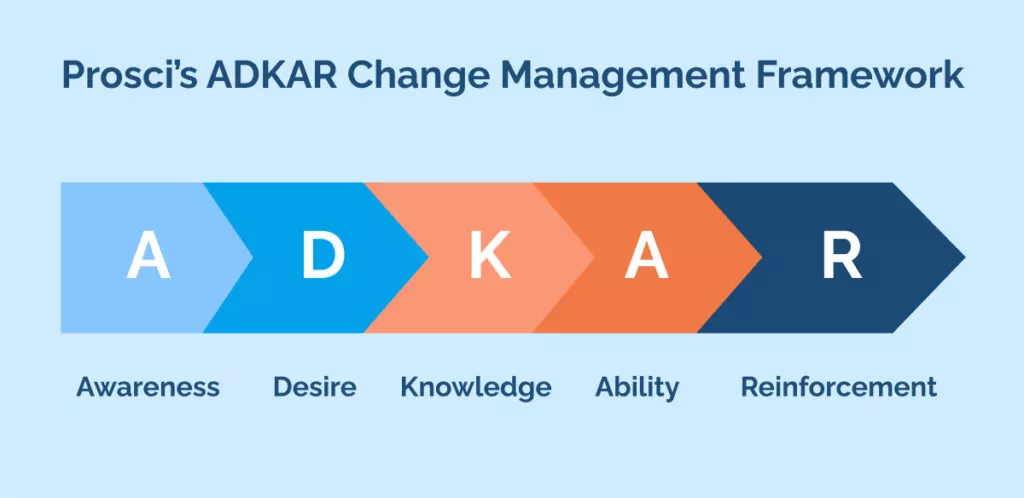
Prosci’s ADKAR change management framework is another theory designed as a roadmap and execution plan.
Like Kotter’s theory, this change management model combines theoretical and practical applications.
How it works
The ADKAR model consists of 5 stages.
These stages include:
- Awareness of the need to change.
- Desire to support change.
- Knowledge of how to change.
- Ability to demonstrate skills and behavior.
- Reinforcement to make the change stick.
Who is it best for?
The ADKAR change model is a favorite among people-centric organizations.
It prioritizes a system that supports employees throughout the change program, and by raising awareness of this need to change, you encourage participation from everyone.
ADKAR helps employees understand how they benefit from change and why they should actively work with the company to streamline the transition.
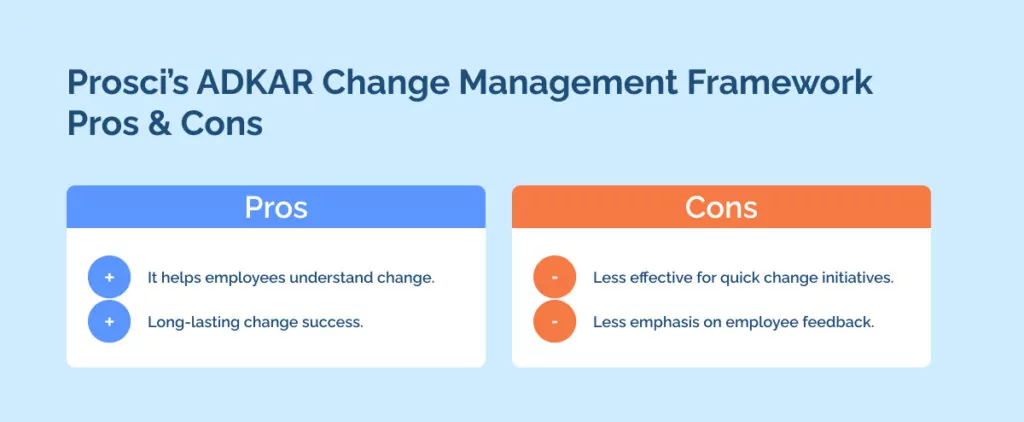
Pros
- It helps employees understand change.
- Long-lasting change success.
Cons
- Less effective for quick change initiatives.
- Less emphasis on employee feedback.
4. Kübler-Ross Change Curve
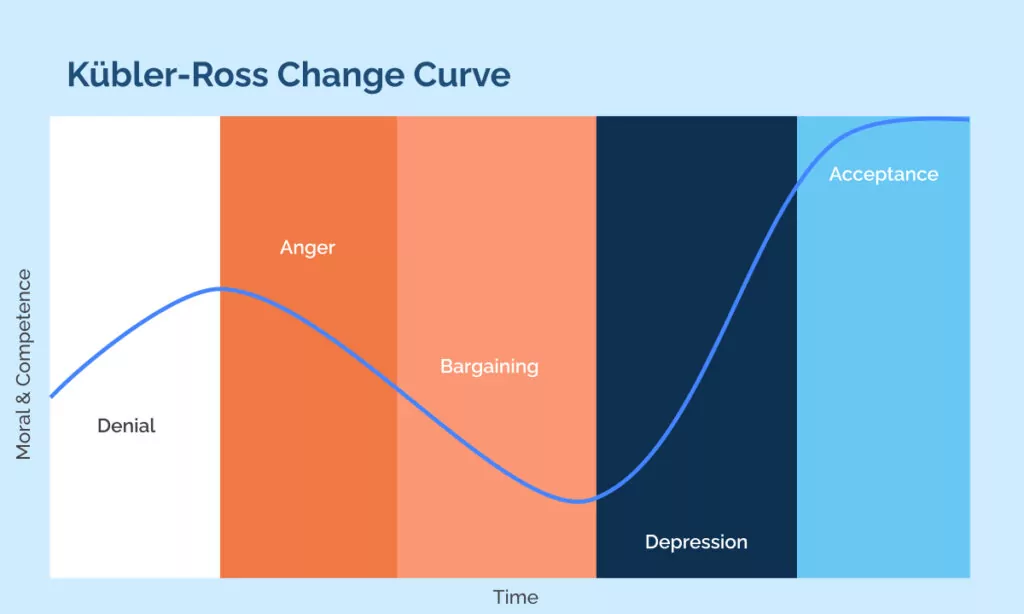
The Kübler-Ross Change Curve is well-known for taking inspiration from the five stages of grief, initially defined by Elisabeth Kübler-Ross.
The change model recognizes that people react emotionally to change.
Business leaders often approach change logically and neglect emotions.
How it works
The Kübler-Ross change model consists of five stages of grief:
- Denial.
- Anger.
- Bargaining.
- Depression.
- Acceptance.
Employees experience these stages out of order, sometimes even experiencing the same emotion multiple times throughout the change process.
The Kübler-Ross Change Curve requires the most empathetic approach out of all the change management models.
Without communication and empathy, employees feel left out of the transformation, and change will not stick, wasting resources and possibly reducing employee retention.
Who is it best for?
The ADKAR change model is a favorite among people-centric organizations.
It prioritizes a system that supports employees throughout the change program, and by raising awareness of this need to change, you encourage participation from everyone.
ADKAR helps employees understand how they benefit from change and why they should actively work with the company to streamline the transition. It encourages organizations to provide adequate training to inform employees of coming changes.
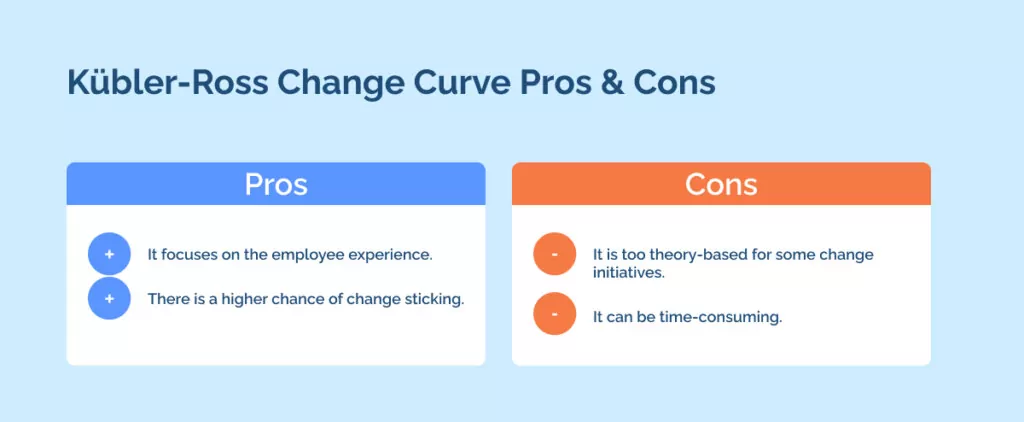
Pros
- It focuses on the employee experience.
- There is a higher chance of change sticking.
Cons
- It is too theory-based for some change initiatives.
- It can be time-consuming.
5. Bridges Transition Model
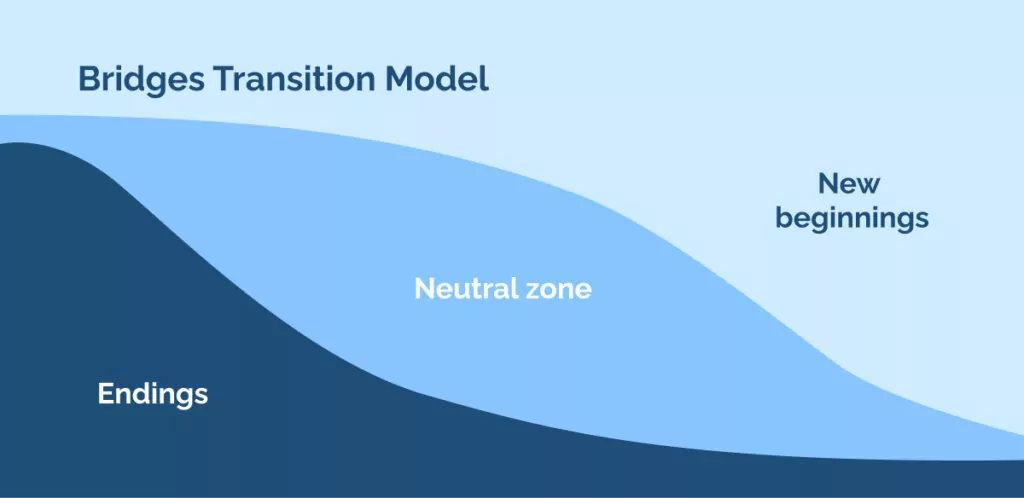
Bridges’ transition model takes a personal approach to change. It asks leaders to consider how change impacts people, reminding leaders that frustration is a natural part of the change.
How it works
The Bridges change model involves breaking up the change journey into three stages.
These stages involve:
1. Ending, losing, and letting go
The first stage involves letting go of familiar ways of working. This process is complex and leads to a lot of resistance.
As Bridges’ model suggests, asking employees to reach the neutral zone is easier.
2. The neutral zone
Think of the neutral zone as a stepping stone between the old way of work and new processes and systems.
It’s a safe place where employees can get a feel for the new status quo. It helps them let go of old methods gradually.
3. The new beginning
The new beginning represents a new familiar. Employees feel more comfortable using new systems, workflows, and processes.
This personal approach connects employees and management, allowing them to tackle transformation together. It guarantees a smoother transition from old to new.
Who is it best for?
The Bridges Transition model is less like strategy-structure systems and more feelings-based, which many employee-focused organizations prefer.
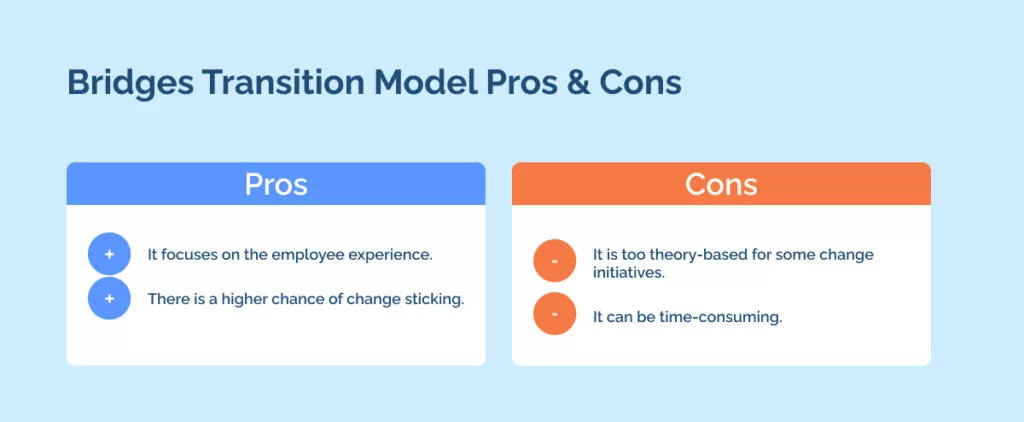
Pros
- It focuses on the employee experience.
- There is a higher chance of change sticking.
Cons
- It is too theory-based for some change initiatives.
- It can be time-consuming.
6. Nudge Theory for change management
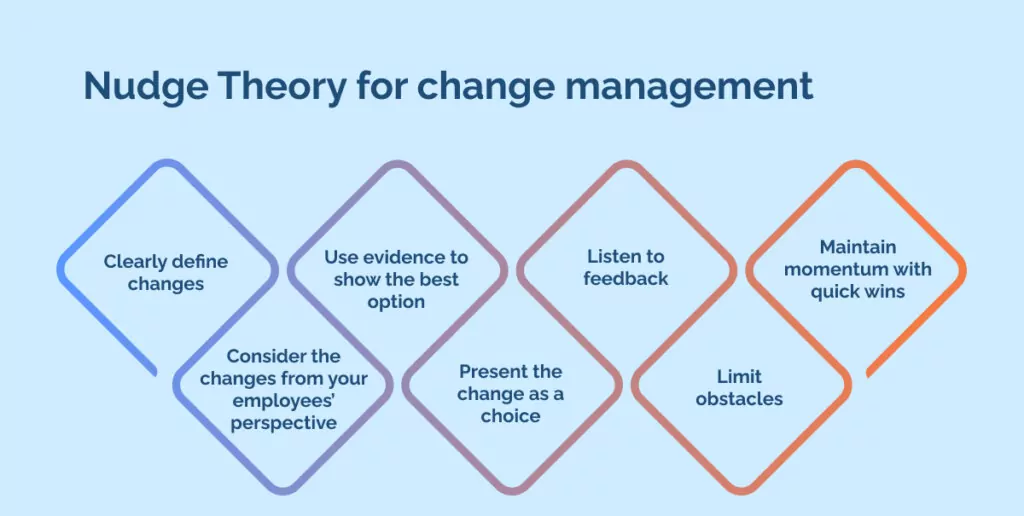
Richard H. Thaler and Cass R. Sunstein introduced the concepts of nudge theory in their book “Nudge: Improving Decisions About Health, Wealth, and Happiness.”
“Nudge theory” is a behavioral science idea suggesting that subtle alterations can predictably influence people’s decisions and behaviors in how choices are presented.
How it works
Nudge theory has seven steps.
These steps incorporate the following actions:
- Clearly define changes.
- Consider the changes from your employees’ perspective.
- Use evidence to show the best option.
- Present the change as a choice.
- Listen to feedback.
- Limit obstacles.
- Maintain momentum with quick wins.
Who is it best for?
Companies have achieved positive results employing nudge theory to motivate staff slowly as part of a long-term change plan involving large changes.
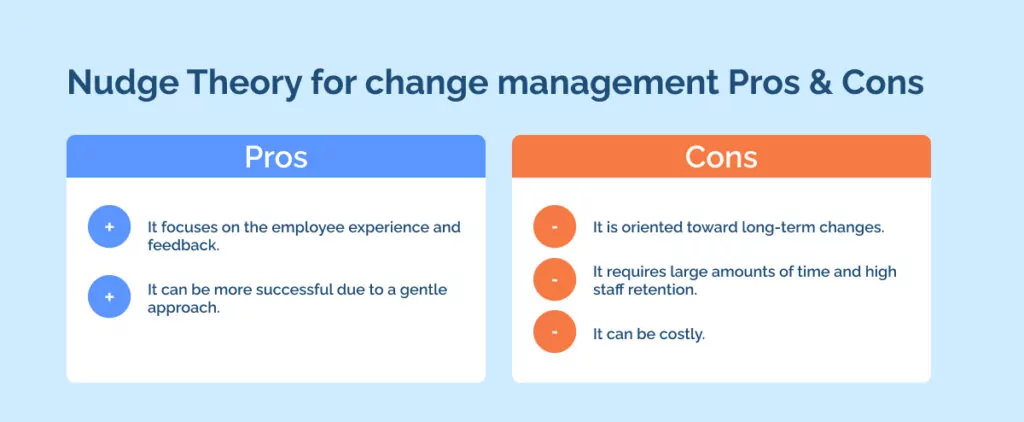
Pros
- It focuses on the employee experience and feedback.
- It can be more successful due to a gentle approach.
Cons
- It is oriented toward long-term changes.
- It requires large amounts of time and high staff retention.
- It can be costly.
7. The Satir change model
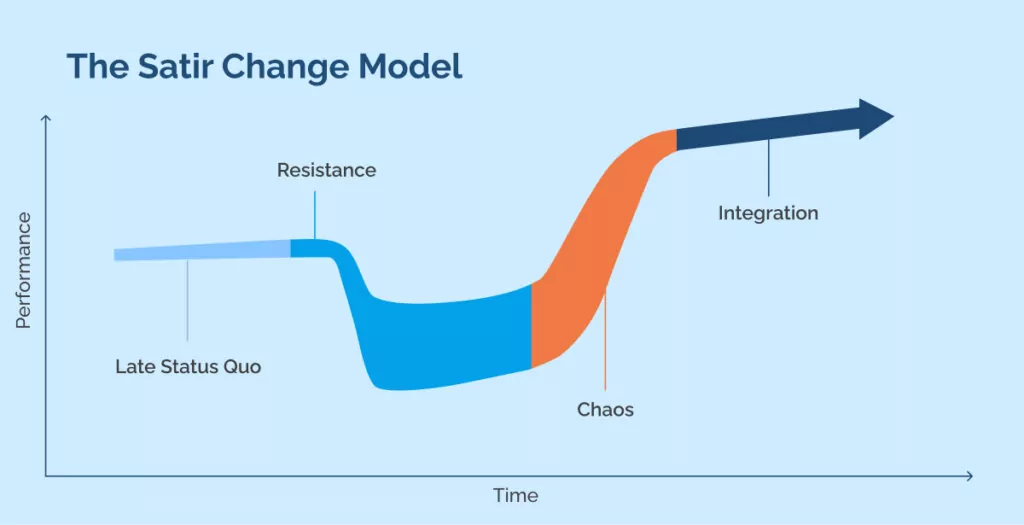
The Satir Change Model is grounded in the five stages of grief, offering a framework to increase employee productivity throughout the change process.
How it works
The Sarir change model is based on the five stages of grief.
The five stages of grief include:
- Late status quo – Employees comprehend the expectations at this stage but may not align with productivity requirements.
- Resistance – Following the introduction of change, initial resistance surfaces, leading to a productivity decline.
- Chaos – Productivity hits its nadir as the change takes an emotional toll; maximum support is crucial for successful implementation.
- Integration – Productivity improvement occurs as employees recognize the positive impact of the change.
- New status quo – Productivity stabilizes, ideally at a higher level, as people accept and integrate the change into their work.
Who is it best for?
This model proves beneficial for teams operating in deadline-oriented settings. Anticipating periods of potential productivity decline enables project managers to establish more lenient project timelines.
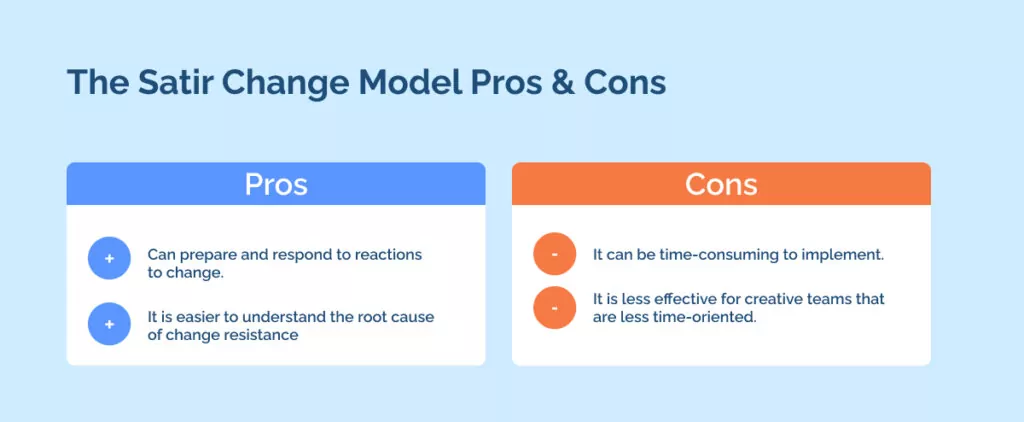
Pros
- Can prepare and respond to reactions to change.
- It is easier to understand the root cause of change resistance.
Cons
- It can be time-consuming to implement.
- It is less effective for creative teams that are less time-oriented.
8. PDSA Cycle change management theory
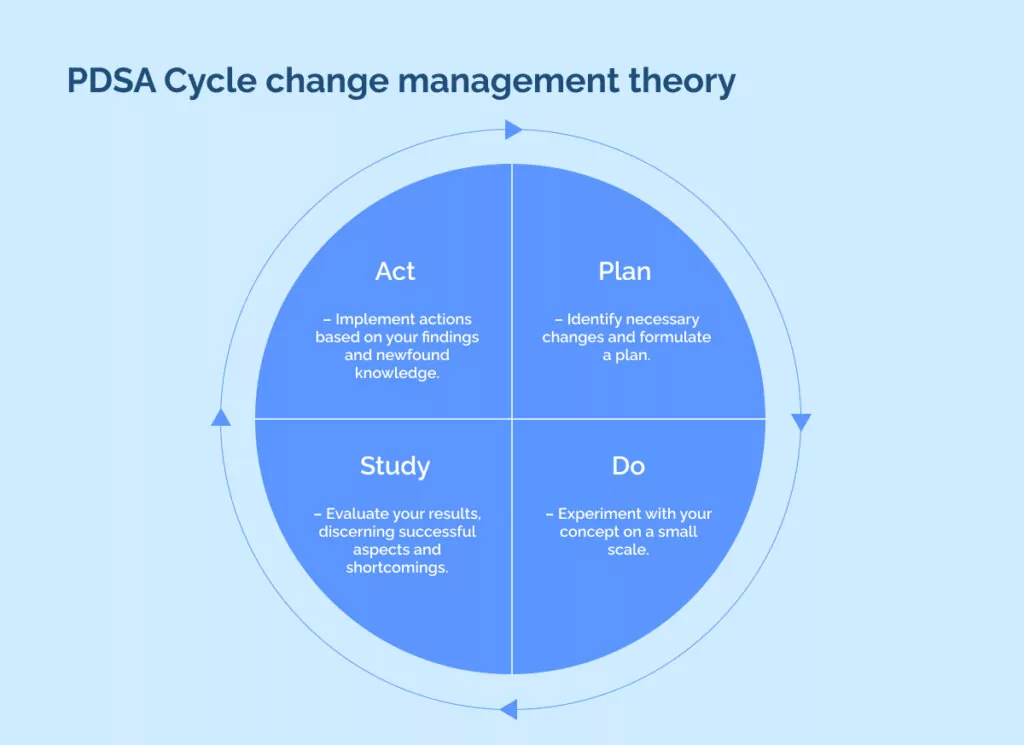
The Plan-Do-Study-Act (PDSA) Cycle is an ongoing process for optimizing and enhancing your business. Rooted in the contributions of W. Edward Deming and Walter Shewhart, it is also known as the Deming Wheel or Deming Cycle.
How it works
The intention is for the cycle to operate in a loop involving repeating the four steps.
These steps involve:
- Plan – Identify necessary changes and formulate a plan.
- Do – Experiment with your concept on a small scale.
- Study – Evaluate your results, discerning successful aspects and shortcomings.
- Act – Implement actions based on your findings and newfound knowledge.
Who is it best for?
We appreciate that in this cycle’s “Study” phase, actual results are compared with projections. This straightforward four-step procedure can be reiterated until the outcomes align with the objectives of process-driven organizations.
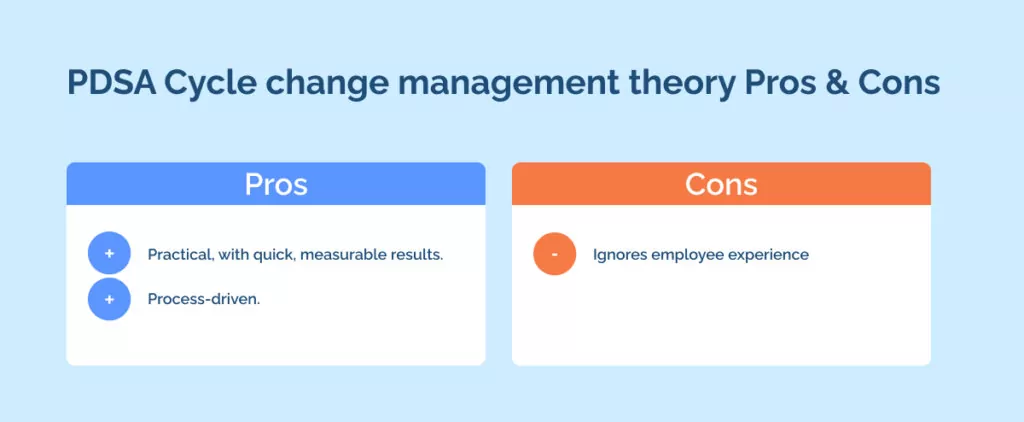
Pros
- Practical, with quick, measurable results.
- Process-driven.
Cons
- Ignores employee experience.
How do you choose the best change management theory?
Many factors determine the success of a change management project. Change management models deal with multiple business areas, and juggling them can be overwhelming.
Relying too much on change management models will remove your focus from other change areas.
When considering change management models for your business, consider the following:
- What methods of change are already in place?
- How will your organization’s structure impact change?
- How do employees and management typically communicate?
- What are the most significant barriers to the change management process in your organization?
Many of the management models featured in this guide overlap in their strategies. We recommend a mixed approach.
The ADKAR, Lewin’s, and Kotter’s management models are the most popular and proven models for change management, but that doesn’t mean they are the right choice for your organization.
For example, Kotter’s model focuses on the role of leadership in change management, while Lewin’s model looks at other driving forces behind organizational change.
Without mastery, change leadership faces plan failure; success demands proven practices.
Take time to choose the correct change management theory
Selecting the appropriate change management theory is crucial for achieving successful organizational transitions.
It is imperative to allocate sufficient time and effort to this decision-making process.
By carefully evaluating the organization’s specific needs, culture, and context, leaders can make informed choices that align with their goals as they begin managing organizational change.
Therefore, selecting the correct change management theory is an investment in the future success and adaptability of the organization, ensuring a smoother journey toward lasting positive transformation.
WalkMe Team
WalkMe spearheaded the Digital Adoption Platform (DAP) for associations to use the maximum capacity of their advanced resources. Utilizing man-made consciousness, AI, and context-oriented direction, WalkMe adds a powerful UI layer to raise the computerized proficiency, everything being equal.


